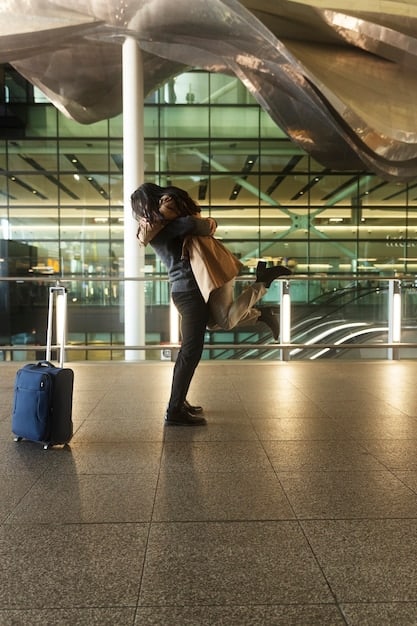Master Hidden City Ticketing: Ultimate Guide to Savings

Anúncios
Navigating the complexities of hidden city ticketing requires understanding its mechanics, identifying legitimate opportunities, and mitigating risks to unlock significant savings on airfare, offering an advanced travel hack for savvy travelers.
Anúncios
In the evolving landscape of air travel, where every dollar counts, discovering unconventional methods to save on flights has become paramount. One such method, often whispered among seasoned travelers, is hidden city ticketing. This guide delves deep into the strategic art of uncovering these unique opportunities, providing you with the insights and tools to potentially slash your travel costs without compromising your journey.
Understanding Hidden City Ticketing: The Core Concept
Hidden city ticketing, also known as “throwaway ticketing,” is a controversial but often effective strategy for reducing airfare costs. It involves booking a flight with a layover city that is your actual desired destination, but the final destination on the ticket is a different, further city. The traveler then simply disembarks at the layover city, effectively “throwing away” the final leg of the journey.
This practice exploits airline pricing algorithms, where indirect flights with multiple legs can sometimes be cheaper than direct flights to the layover city. Airlines price their routes based on algorithms that factor in demand, competition, and various other metrics, often resulting in seemingly illogical pricing disparities. For instance, a flight from New York to San Francisco with a layover in Denver might be less expensive than a direct flight from New York to Denver, making Denver the “hidden city” destination.
Anúncios
The Mechanics Behind Fare Discrepancies
The apparent paradox of a longer journey costing less than a shorter one stems from several factors. Airlines often try to monopolize certain routes, making direct flights more expensive. Conversely, they might offer competitive prices on routes with layovers to attract passengers who would otherwise choose a direct competitor. Supply and demand also play a significant role; if a particular route is oversaturated with options, prices tend to be lower.
- Route Competition: Airlines compete heavily on popular routes, driving down prices for multi-leg journeys.
- Demand Dynamics: Pricing is highly sensitive to demand for specific origin-destination pairs.
- Hub Strategies: Airlines use their hub airports to funnel passengers, sometimes offering cheaper onward connections.
Understanding these intricacies is crucial for identifying potential hidden city opportunities. It’s not about finding a “loophole” in the traditional sense, but rather a strategic advantage derived from the complex and often counter-intuitive world of dynamic airline pricing.
Before considering this method, travelers must have a working understanding of how these fare differences arise. It involves more than just a quick search; it demands a patient and analytical approach to deciphering fare structures and recognizing when an opportunity presents itself. Knowledge of major airline hubs and their pricing tendencies can give you a significant edge in this niche area of travel hacking.
Identifying Potential Hidden City Routes
Uncovering hidden city opportunities requires a systematic approach and an understanding of how to leverage flight search engines. While traditional search engines like Google Flights or Kayak can assist, specialized tools and a keen eye for unusual pricing are essential. The goal is to find flights where the layover city is your true destination and the total cost is significantly less than a direct flight to that layover city.
Start by searching for flights to cities beyond your actual destination, using your desired layover city as a filter or mental note. For example, if you want to fly to Chicago, search for flights to Dallas with a layover in Chicago or to Denver with a Chicago layover. You’ll need to compare the prices of these multi-leg tickets against direct flights to Chicago.
Specialized Search Tools and Techniques
Nomad by Kiwi.com is arguably the most well-known tool specifically designed to help identify hidden city flights. It allows users to input multiple destinations, and the algorithm attempts to find the cheapest combination of flights, often revealing hidden city options. Other tools might not explicitly market themselves for this purpose but can be used strategically.
- Skiplagged: This platform is infamous for explicitly highlighting hidden city flights and has faced legal challenges from airlines.
- ITA Matrix Airfare Search: A powerful, albeit complex, tool used by travel agents, it can reveal detailed fare rules and routings that might expose hidden city options.
- Flexible Date Searches: Being flexible with your travel dates can open up more opportunities, as pricing is highly dynamic.
When using any search engine, always check one-way flights versus round trips. Hidden city ticketing is almost exclusively a one-way strategy because using it on a round trip would involve missing the first leg of your return journey, which typically leads to the cancellation of all subsequent flights on that itinerary by the airline.
Carefully note the airline, flight numbers, and layover times. Ensure the layover is long enough for you to comfortably exit the airport. Also, always verify that your bags will not be checked through to the final destination, which can be a common pitfall. The entire strategy hinges on the ability to leave the airport at your desired hidden city.

Risks and Considerations: What You Need to Know
While the allure of cheaper flights is strong, engaging in hidden city ticketing comes with inherent risks and important considerations. Airlines strongly discourage this practice, viewing it as a breach of contract, and they reserve the right to penalize passengers who engage in it. Understanding these potential consequences is paramount before attempting such a strategy.
The primary concern is that airlines may penalize you, though the exact repercussions can vary. Penalties might include revoking frequent flyer miles, canceling future flights booked with the same airline, or even charging the difference between the hidden city fare and the direct flight fare to your intended layover city. While these are less common, they are possibilities travelers should be aware of.
Mitigating Potential Downsides
To minimize risks, consider these crucial points. Firstly, never check luggage. Your bag will almost certainly be checked through to the final destination on the ticket, making hidden city ticketing impossible for anything more than carry-on. You must be able to travel with only what you can bring onto the plane.
- No Checked Luggage: Essential to ensure your belongings don’t end up at the phantom final destination.
- One-Way Travel: Only book one-way tickets. Missed segments on a round trip will lead to cancellation of subsequent flights.
- Avoid Frequent Flyer Accounts: Do not link your frequent flyer number to hidden city itineraries, as airlines can track travel patterns and potentially penalize mile accounts.
- No Repeat Offenders: Avoid using the same airline repeatedly for hidden city travel, as this increases your risk of detection.
Connections involving partner airlines can add another layer of complexity. If your hidden city flight has multiple segments on different airlines, understanding their baggage policies and potential code-sharing agreements becomes critical. Direct flights, even with a layover to be exploited, minimize this risk.
Be aware of specific airline policies, as some are more aggressive than others in pursuing passengers who engage in hidden city ticketing. While it’s generally difficult for airlines to “catch” individual travelers, repeated use might draw unwanted attention. Always remember that flexibility and discretion are key when exploring these unconventional ticketing methods.
Practical Tips for Successful Hidden City Travel
Executing a hidden city trip successfully requires careful planning and adherence to specific strategies. It’s not just about finding the cheap fare; it’s about navigating the practicalities of travel to ensure a smooth experience without alerting the airline to your true intentions. The details matter significantly in this unique form of travel hacking.
Always book one-way tickets to your hidden city destination. If you need a round trip, book two separate one-way tickets – one to your hidden city for the outbound journey and a completely separate normal one-way ticket for your return. This isolates the hidden city segment, preventing the airline from canceling your return flight due to a missed segment.
Essential Strategies for a Smooth Journey
- Carry-On Only: This is non-negotiable. If you check a bag, it will be sent to the final destination on your ticket, not your intended layover city.
- Check Boarding Passes: Ensure you are issued all boarding passes for the entire itinerary. Sometimes, airlines will only issue the first segment’s pass, requiring you to check in again for the connecting flight, which could raise questions.
- No Frequent Flyer Number: Do not add your frequent flyer number to the reservation. This prevents airlines from tracking your behavior and potentially penalizing your miles or status.
- Don’t Act Suspicious: When boarding, act like any other passenger traveling to the final destination. Avoid discussing your plans loudly.
- Be Prepared for Questions: If asked, state your destination is the final one on your ticket. Don’t volunteer information about your hidden city plan.
Flexibility is your friend. If there’s a flight change or cancellation, the airline might re-route you, potentially bypassing your intended hidden city layover. Have a backup plan, and understand that some risk of itinerary changes exists.
Also, never contact the airline to make changes or ask questions about your hidden city segment. Any inquiries could trigger scrutiny. Treat the transaction as a standard booking to the final destination, and quietly disembark at your intended layover. This subtle approach helps maintain the integrity of your hidden city strategy.
Legality and Airline Stance: Navigating the Grey Area
The practice of hidden city ticketing operates in a legal grey area. While not explicitly illegal in the criminal sense, it is a clear violation of the “Contract of Carriage” that passengers agree to when purchasing a ticket. Airlines explicitly prohibit “throwaway ticketing” and “back-to-back ticketing” in their terms and conditions, which passengers implicitly accept upon purchase.
Airlines view hidden city ticketing as an attempt to circumvent their pricing structures and unfairly exploit their system. They argue that their layered pricing models are complex and designed to maximize revenue, and passengers interfering with this model are causing financial losses. This is why they have the right to impose penalties, as outlined in their Contract of Carriage.
Airline Responses and Legal Precedents
Historically, airlines have taken various measures against hidden city ticketing. United Airlines, for example, famously sued Skiplagged, a website that specializes in finding these fares, although the lawsuit was later dismissed. This indicates the airlines’ strong disapproval, even if enforcing blanket prohibitions is challenging.
- Contract Violation: Airlines consider it a breach of agreement, giving them grounds to act.
- Penalties: Potential consequences include loss of frequent flyer miles, future flight cancellations, or direct billing for the fare difference.
- Website Blocking: Some airlines have attempted to block or restrict access for individuals or IP addresses suspected of frequent hidden city searches.
- Data Analysis: Airlines use sophisticated data analytics to identify patterns indicative of hidden city behavior, though this is primarily geared towards repeat offenders.
Passengers should be aware that while individual instances might go unnoticed, repeated use, especially with the same airline, significantly increases the risk of detection and potential repercussions. The focus typically falls on travelers who make this a consistent means of travel, attempting to leverage what airlines deem a “loophole” repeatedly.
It’s important to weigh the potential savings against the risks. For a single, significant trip, the risk might be deemed acceptable by some. However, for regular commuters or those heavily reliant on frequent flyer programs, the potential for account termination or financial penalties might outweigh the benefits. Always proceed with caution and full awareness of the airline’s perspective.
Future of Hidden City Ticketing: What to Expect
The landscape of air travel and airline pricing is constantly evolving, and so too is the practice of hidden city ticketing. As airlines become more sophisticated in their pricing algorithms and fraud detection, the opportunities and risks associated with this method will continue to shift. Travelers keen on leveraging this hack must remain adaptable and informed.
Airlines are continually investing in dynamic pricing tools that can respond rapidly to market changes and detect anomalies. While direct lawsuits against individual passengers for hidden city ticketing are rare, airlines could explore more aggressive technological solutions to prevent these bookings or enforce their Contracts of Carriage more strictly.
Technological Advancements and Passenger Adaptation
One potential future development could be more intricate fare rules that make hidden city routing less financially viable. Airlines might adjust their pricing to reduce the artificial savings seen in indirect routes, or they could implement stricter baggage and check-in procedures that inadvertently thwart the strategy.
- AI-Powered Pricing: Advanced AI could minimize pricing discrepancies that create hidden city opportunities.
- Real-Time Tracking: Enhanced passenger tracking could flag suspicious travel patterns more readily.
- Stricter Check-in: Airlines might require in-person check-ins for connecting flights, making it harder to simply disembark.
- Legal Precedents: While currently a grey area, future legal challenges or clearer regulations could emerge globally.
However, as airlines innovate, so do travelers. The online community of travel hackers is resilient and constantly shares new strategies and insights. New tools or modifications to existing ones may emerge, continuing the cat-and-mouse game between airlines and savvy travelers.
The advice for hidden city ticketing will likely remain consistent: travel light, book one-way, and be discreet. The core principles of saving money through this method will probably persist as long as airlines maintain complex, demand-driven pricing models. The key for travelers is to stay informed about the latest strategies and, crucially, the updated policies of the airlines they choose to fly with, ensuring continued safe and effective use of this travel hack.
Ethical Considerations and Best Practices
Beyond the legal and financial risks, travelers often grapple with the ethical implications of hidden city ticketing. While many view it as a clever way to beat the system, airlines consider it unethical and a breach of trust. Understanding these differing perspectives can help travelers make informed decisions aligned with their personal values.
From a consumer perspective, the argument often hinges on the idea that if airlines price their tickets illogically, then consumers are simply exploiting a market inefficiency. Why pay more for a shorter flight if a longer one is cheaper? This perspective emphasizes the consumer’s right to seek the best value for their money.
Navigating the Moral Compass of Travel Hacking
On the other hand, airlines invest heavily in route planning, fleet management, and complex pricing algorithms designed to optimize their operations and profitability. When a passenger intentionally circumvents these design principles, it can be viewed as unfair and potentially harmful to the airline’s business model. This could, in theory, lead to higher prices for all passengers in the long run.
- Fairness vs. Exploitation: Is it fair to exploit a pricing anomaly, or is it taking advantage of a system?
- Airline Profitability: Does widespread hidden city ticketing genuinely impact airline profitability and lead to higher fares?
- Terms of Service: By agreeing to the Contract of Carriage, passengers implicitly agree to certain rules; is breaching them ethical?
For most individual travelers, the ethical dilemma is minor, often outweighed by the significant savings. However, for those who value strict adherence to rules or are concerned about contributing to potential aggregate impacts on airline pricing, it’s a consideration. The decision often comes down to personal comfort with operating in a “grey area.”
The best practice, regardless of your ethical stance, is to remain discreet and informed. Always be aware of the airline’s latest policies and any public statements regarding hidden city ticketing. Travel hacks, by their nature, push boundaries, and it’s up to each traveler to decide how far they are willing to go in pursuit of savings, balancing financial gain with potential risks and ethical considerations.
| Key Point | Brief Description |
|---|---|
| ✈️ Concept Clarity | Book to a further city with your destination as the layover, then disembark. |
| ⚠️ Risks Involved | Airline penalties, lost frequent flyer miles, future booking cancellations. |
| 🎒 Travel Light | Always use carry-on only; checked bags go to the final destination. |
| 🛡️ Avoid Tracking | Do not use frequent flyer numbers; book one-way tickets separately. |
Frequently Asked Questions About Hidden City Ticketing
Hidden city ticketing is not illegal in a criminal sense, but it does violate most airlines’ Contracts of Carriage. This means airlines can take civil action, such as revoking miles, charging fare differences, or canceling future flights, though actual enforcement against individual travelers is rare.
No, you absolutely cannot check luggage. Checked bags are always routed to the final destination on your ticket, not your intended layover city. For hidden city travel, you must be able to travel with only carry-on items that will stay with you during the entire journey.
Flight changes or cancellations can disrupt your hidden city plan. If the airline re-routes you to a different connection city or a direct flight, your intended stop may be bypassed. Airlines are not obligated to accommodate your hidden city intention; always have a backup plan.
Yes, it can. Airlines track passenger activity linked to frequent flyer accounts. Engaging in hidden city ticketing, especially repeatedly, might lead to the revocation of miles, status, or even account termination if detected. It’s advisable to book these types of flights without associating your frequent flyer number.
While policies generally align, some airlines, particularly those based in the US like United, have been more vocal or even pursued legal action against entities promoting hidden city ticketing. However, direct penalty enforcement against individual, non-frequent offenders varies widely and is not consistently reported.
Final Thoughts on Smart Fare Strategies
Navigating the complex world of airfare can be daunting, but with strategies like hidden city ticketing, travelers gain an edge. While this method offers considerable savings, it’s a technique that demands respect for its risks and a commitment to meticulous planning. Understanding the nuances, embracing the “carry-on only” mantra, and maintaining discretion are critical to its successful application. As air travel continues to evolve, the ability to adapt and think unconventionally will remain a valuable asset for any savvy globetrotter.





